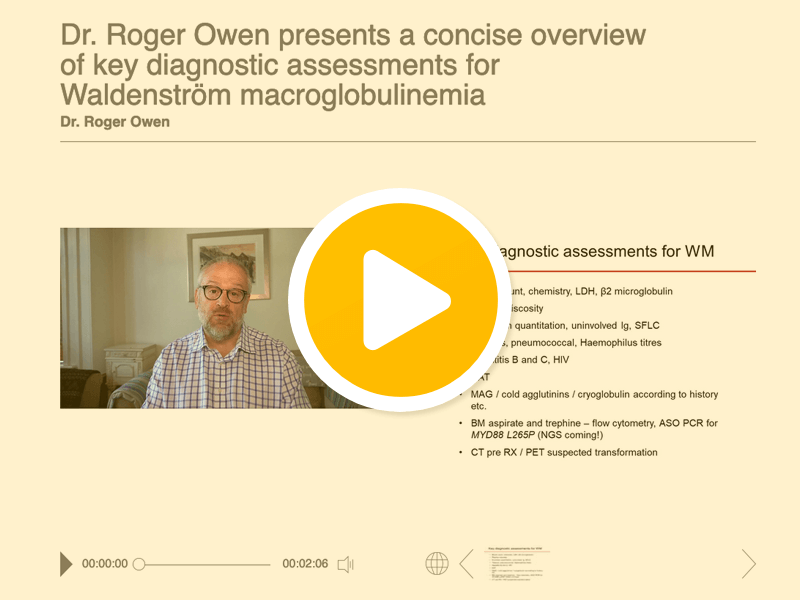Diagnosis
Learn more about the diagnosis of Waldenström’s macroglobulinemia.
The diagnosis of Waldenström's macroglobulinemia
Waldenström's macroglobulinemia diagnosis is made when bone marrow samples show ≥10% of the cells to be lymphoplasmacytoid lymphoma cells, and serum electrophoresis shows the presence of excessive monoclonal IgM.1
If signs or symptoms suggest that a person might have Waldenström's macroglobulinemia, various exams and tests will be done. The most important tests will look for abnormal proteins in the blood and abnormal cells in the bone marrow.
Diagnostic workup by the patient's physician as per the ESMO guidelines may include2:
- Medical history – taking note of typical B symptoms like fever night sweats and weight loss, possible risk factors, family history (including Waldenström's macroglobulinemia and other B cell lymphoproliferative disorders), and other medical conditions.
- Physical exam - with particular attention to lymph nodes and areas of the body that might be involved. This may include, organomegaly, hyperviscosity symptoms, neuropathy, Raynaud’s disease, rash, peripheral oedema, skin abnormalities, dyspnea.
- Include fundoscopic examination if IgM is high and hyperviscosity is suspected
- Laboratory studies - which might involve referral to a hematologist or an oncologist
Laboratory tests1,2
- Complete blood count
- Complete metabolic panel
- Serum Ig levels (IgA, IgG, IgM) – in Waldenström's macroglobulinemia the IgM level is high but IgG is often low
- Serum and urine electrophoresis with immunofixation - to validate the IgM heavy chain and the type of light chain
- Serum ß2 microglobulin level
- Viral serology (HBV, HCV and HIV) – especially before initiation of therapy
- *Cryoglobulins
- *Cold agglutinin titre
- *Serum viscosity - when signs and symptoms of hyperviscosity syndrome are present or when IgM >4000 mg/dL
- *Screening for acquired von Willebrand disease
- *24-h urine protein quantification - monoclonal light chains are detected in the urine of 40%-80% of patients tested
- *Serum free light chains
- *N-terminal pro b-type natriuretic peptide, cardiac troponins
- *Electromyogram, anti-MAG (myelin-associated globulin antibody), anti-GM1 (anti-ganglioside M1)- will require consultation with a neurologist
*if clinically indicated

Bone marrow aspiration and biopsy
- BM aspiration and biopsy - at least 10% of the cells in the bone marrow must be lymphoplasmacytoid lymphoma cells.1
- The clonal lymphoplasmacytic cell population in the BM (which contains a population with lymphocytic differentiation and plasmacytic differentiation) should be documented by a trephine biopsy and/or aspiration and confirmed by immunophenotypic studies including2:
- Immunohistochemistry (IHC, required for diagnosis)2
- Flow cytometry (optional; consider if IHC not available; WM cells are typically positive for CD19, CD20, CD22 and CD79a on the lymphocytic as well as CD38 on the plasmacytic component)2
- Testing for MYD88L265P gene mutation2
- Cytogenetic studies with optional fluorescence in situ hybridization may be performed1

Imaging tests
- CT of the chest, abdomen and pelvis (if clinically indicated and in all patients being considered for therapy)2
- CT of abdomen and pelvis is used to detect organomegaly and lymphadenopathy (a skeletal survey and radiographic imaging of the bones are unnecessary in the absence of symptoms; lytic bone lesions are unusual).1
- Other imaging tests if clinically indicated may include, CT-guided needle biopsy, magnetic resonance imaging (MRI), ultrasound and positron emission tomography (PET) scan.

Staging of Waldenström's macroglobulinemia
- Unlike some other cancers, there is no standard staging system for Waldenström's macroglobulinemia based on the extent of the disease in the body because this hasn’t been shown to be important for outcomes or treatment decisions.
- Instead, physicians have used other factors that seem to predict a poorer outcome to develop the International Prognostic Scoring System for Waldenström's macroglobulinemia3:
- Age >65y, hemoglobin ≤11.5 g/dL, platelets ≤100 x 109/L, β2- microglobulin >3 mg/L, serum monoclonal IgM >7 g/dL
- Except for age, each factor is worth a single point. The points are added to make a score, which is used to divide patients into 3 risk groups:
| Risk Group | Scoring | 5-year survival |
|---|---|---|
| Low | ≤65y with ≤ 1 point | 87% |
| Intermediate | >65y with ≤ 2 points, or ≤65y with 2 points | 68% |
| High | any age with ≥ 3 points | 36% |
Expert perspective of key diagnostic assessments for Waldenström's macroglobulinemia
Lecture: Dr. Roger Owen presents a concise overview of key diagnostic assessment for Waldenström macroglobulinemia.
In this excerpt from the BeiGene satellite symposium at EHA 20204, Dr. Roger Owen discusses the key diagnostic assessments that should be undertaken in newly presenting patients.
Dr. Owen describes how the basic workup should include basic blood count, chemistry, LDH and ß2-microglobulin. He adds that preferably plasma viscosity should be measured regularly if possible. Further assessments should include M-protein quantitation, measurement of uninvolved Ig and serum-free light chains (SFLC). The latter is due to the fact that a minority of patients have an excess of light chains, and a small minority are at risk of renal disease as a consequence of this.
Other tests that should be undertaken for all lymphoma patients including immunity levels for tetanus and pneumococcal infections, and hepatitis B hepatitis C and HIV status prior to therapy. Depending on patient history, MAG antibodies, cold agglutinin disease (CAD) and cryoglobulins should be considered. In patients where bone marrow testing is necessary, a bone marrow aspirate and trephine biopsy should be used to look for WMB cells by flow cytometry. The MYD88 mutation should be tested for by PCR. Dr. Owen concludes that CT scanning and PET imaging are not generally used unless there are concerns of histological transformation.
Prognostic model in asymptomatic Waldenström macroglobulinemia patients
In this excerpt from the BeiGene satellite symposium at EHA 20204, Dr. Roger Owen discusses the benefits of using a web-based prognostic model in asymptomatic Waldenström's patients.
Dr. Owen describes a prognostic model recently developed by Mark Bustoros and colleagues at the Dana-Farber Cancer Institute in Boston.5 The web-based application allows for the prediction of outcome and risk progression in asymptomatic patients, using input of bone marrow infiltration and levels of IgM protein, ß2-microglobulin and albumin.
Rather than dichotomizing prognostic variables, this model utilizes prognostic variables in a continuous manner. The application generates a risk score, a risk group of low, medium or high, and a median time to progression.
Dr. Owen explains that this can be particularly useful in discussing risk of progression with patients who struggle with the ‘watch and wait’ strategy.




